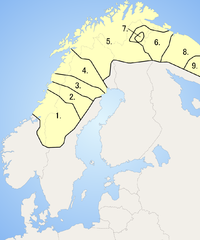
Photo from wikipedia
The diet of the Indigenous Sami people has become more Westernized. The lack of population-based data on nutrient intake and nutritional adequacy, in combination with a high prevalence of obesity/metabolic… Click to show full abstract
The diet of the Indigenous Sami people has become more Westernized. The lack of population-based data on nutrient intake and nutritional adequacy, in combination with a high prevalence of obesity/metabolic syndrome among Sami, was the rationale behind the present study. We hypothesized that differences in nutrient intake between Sami and non-Sami populations may still exist but that these differences are likely small, especially with respect to nutritional contributors to cardiometabolic health. We used cross-sectional data from the SAMINOR 2 Clinical Survey (2012-2014) to study nutrient intake, assessed by a food frequency questionnaire, in 2743 non-Sami, 622 multiethnic Sami, and 1139 Sami participants aged 40-69 years. We applied quantile regression to study ethnic and inland/coastal regional differences. The median intake of most nutrients met the Estimated Average Requirements of the 2012 Nordic Nutrition Recommendations. However, the average intake of saturated fatty acids and sodium was higher, and average intake of fiber was lower than recommended, regardless of ethnicity and geographic region. The diet of Sami vs non-Sami participants and participants from the inland vs coastal region contained significantly more iron and vitamin B12. We found a number of statistically significant ethnic differences in nutrient intake; however, many of these differences were small (3%-4%). We observed no ethnic disparities in nutritional adequacy between Sami and non-Sami populations living in rural Northern Norway. Our results suggest that, compared to the non-Sami, the Sami have a dietary intake that may reduce their risk of iron deficiency but not their cardiometabolic risk.
Journal Title: Nutrition research
Year Published: 2019
Link to full text (if available)
Share on Social Media: Sign Up to like & get
recommendations!